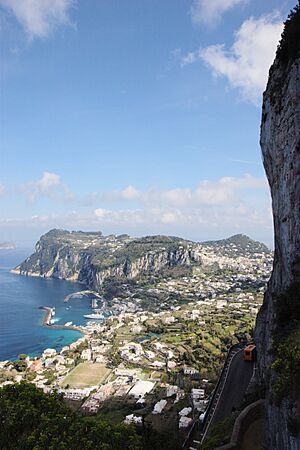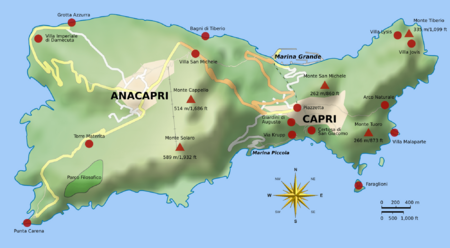History of Capri facts for kids
The island of Capri is in the Gulf of Naples, located between the Italian Peninsula and the islands of Procida and Ischia. It's made of limestone, with a lower center and high, steep sides that have many caves. The island's shape is dominated by the slopes of Monte Solaro in the west and Monte San Michele in the east.
Contents
Capri's Ancient Past

Early Discoveries
The first signs of ancient life on Capri were found over two thousand years ago. During the Roman Empire, workers digging for new buildings found bones of animals that had been gone for thousands of years. They also found traces of people from the Stone Age. The historian Suetonius wrote about this. He said that Emperor Augustus was very interested in these finds. Augustus even created the first museum of ancient life (paleontology) and early humans (paleoanthropology) in his villa's garden.
First Inhabitants and Greek Settlers
Legend says the first people on Capri were the Teleboi from Acarnania. Later, in 1882, remains from the New Stone Age (Neolithic period) were found in a cave called Grotta delle Felci on the south coast.
In historical times, Greeks settled on Capri. They first came to Ischia and the mainland at Cumae around the 8th century BC. The historian Strabo mentioned that Capri once had two towns, which later became one.
The Two Ancient Towns
One of these towns was the early version of today's Capri town. We know this from old walls made of large stones, which you can still see near the funicular railway. There were also other buildings, now gone, that made up this old town from the 5th to 4th century BC.
The second town is believed to be Anacapri. This idea comes from the famous Phoenician Steps that connect Anacapri to the port. Even though they are called "Phoenician," these steps were actually built by Greek settlers.
From the very beginning, the island's natural shape led to two separate communities. One was in the east, with hills sloping to the sea. The other was in the west, on a large flat area near the steep slopes of Monte Solaro, but without direct access to the sea.
Later, Capri became part of Neapolis (which is now Naples). It stayed that way until Emperor Augustus took it. He traded Capri for the island of Aenaria (Ischia) and often stayed on Capri himself.
Capri in Roman Times
Emperor Tiberius's Retreat
Emperor Tiberius spent the last ten years of his life on Capri. He built twelve villas there! The most famous one is Villa Jovis, and you can still see its impressive ruins today. Many of these villas have been identified. One of the best-preserved is in Anacapri, with many arched structures and possibly the base of a lighthouse. Other villas include the Palazzo a Mare, Villa di Gradola (which included the Blue Grotto), and Villa Damecuta. Ruins of another villa near Tragara were still visible in the 1800s. South of Villa Jovis, there are remains of a watch tower used to send messages to the mainland.
The island has many ancient water tanks. This shows that, just like today, people in Roman times collected rainwater for drinking, as Capri has no natural springs.
Tiberius likely moved from Rome to Capri because he was tired of the political struggles in Rome. He also feared being attacked. Villa Jovis is in a very private part of the island. Tiberius's own living areas in the villa were especially hard to reach and were heavily guarded.
Some ancient writers, like Suetonius in his book Lives of the Twelve Caesars, claimed that Villa Jovis was a place of wild parties for Tiberius. However, many modern historians believe these stories were just mean rumors spread by his enemies. They think he lived a quiet, private life on the island.
Capri After Tiberius
After Tiberius died, emperors didn't visit Capri much. It was mainly used as a place to send people away, like the wife and sister of Emperor Commodus. The island was first owned by Neapolis and then by the emperors. It never had its own local government. Even in Roman times, people mostly spoke Greek there, which we know from both Greek and Latin writings found on the island.
From the Middle Ages to the 19th Century
Pirate Attacks and New Rulers
After the Western Roman Empire fell, Capri went back under the rule of Naples. The island suffered many attacks and raids by pirates. In 866, Emperor Louis II gave Capri to the town of Amalfi. Capri's connection to Amalfi, which traded with the Eastern Mediterranean, can be seen in its art and buildings, which show Byzantine and Islamic styles. In 987, Pope John XV appointed the first bishop for Capri.
In 1496, Frederick IV of Naples made the two settlements of Capri and Anacapri equal in law and government. Pirate raids by the Barbary corsairs became very frequent during the time of Charles V. The old medieval town was on the north side, near the main landing place (Marina Grande). It had the church of S. Costanzo, an early Christian building. But in the 15th century, people left this town because of pirate attacks. They moved higher up to Capri and Anacapri for safety.
The Infamous Barbarossa
The pirate Barbarossa Hayreddin Pasha, known as Barbarossa, attacked and burned Capri seven times. The worst raid was in 1535, when Barbarossa captured the island for the Ottoman Empire. He burned down Anacapri castle, whose ruins are now called Castello Barbarossa. This castle is now on the land of Villa San Michele. In 1553, another pirate, Turgut Reis, invaded again. He captured, looted, and destroyed the Certosa di San Giacomo monastery.
Because of these dangerous attacks, Charles V allowed the islanders to arm themselves. New towers were built to defend Capri. This threat from pirates finally ended in 1830, when the French defeated them in Algeria.
New Visitors and Discoveries
In the 17th century, a French scholar named Jean-Jacques Bouchard visited the island. He might be considered Capri's first modern tourist. His diary, found in 1850, gives us important information about Capri from that time.
In January 1806, French soldiers led by Bonaparte took control of Capri. But in May 1806, a British fleet led by Sir Sidney Smith took the island from the French and made its defenses stronger. However, in 1808, the French, led by Lamarque, recaptured it. They pretended to attack the two ports, Marina Grande and Marina Piccola. This made the British focus their attention there. Meanwhile, the French climbed the cliffs on the west coast and forced the British to give up. In 1813, Capri was given back to Ferdinand I of the Two Sicilies.
In the late 1800s, Capri became a popular place for European artists, writers, and famous people. Some of them were Norman Douglas, Friedrich Alfred Krupp, Jacques d'Adelswärd-Fersen, Christian Wilhelm Allers, Emil von Behring, Curzio Malaparte, Axel Munthe, and Maxim Gorky. The book that made Capri so popular in France, Germany, and England was Entdeckung der blauen Grotte auf der Insel Capri (Discovery of the Blue Grotto on the Isle of Capri) by German painter and writer August Kopisch. In this book, he described his visit to Capri in 1826 and how he (re)discovered the Blue Grotto.
Also in the 19th century, the natural scientist Ignazio Cerio studied and listed all the plants (flora) and animals (fauna) found on Capri.






